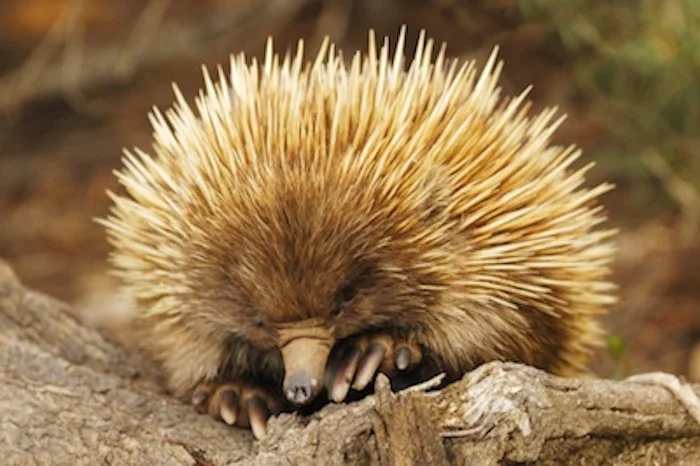Echidnas have hair and spikes on their body.
They have big, strong claws for digging.
Echidnas live in thick forests.
An echidna has a long sticky tongue to catch termites and ants.
Echidnas dig themselves into the ground if they are chased.
A special animal group
The echidna (say eh-kid-nuh), also called spiny anteater, belongs to a small, special group of mammals called monotremes, which are animals that lay eggs but feed their babies milk.
An echidna in a hollow log ©Getty Images
There are only three monotreme species (kinds) in the world,
Two of these species are echidnas. The short-beaked echidna is found in Australia and the southern part of New Guinea, and the long-beaked echidna is found only in New Guinea.
A short-beaked echidna©Getty Images
The only other monotreme, found only in Australia, is the platypus.
Echidnas are found throughout Australia, in a wide range of habitats and climates. They shelter in rocks or logs.
Because these small, shy creatures live alone in forest areas, not much is known about their habits.
Behaviours
Echidnas are solitary animals, meaning they live alone, meeting up at breeding times when there will be a group of males following a female.
Echidnas have an excellent sense of smell, using their snouts to poke about through leaf litter and rotten logs in the search for food.
If threatened, the echidna can roll up into a ball of spikes that predators leave alone. The echidna can also dig so fast that it seems to sink into the ground, leaving only spikes showing, to escape threats from animals such as eagles, dingoes, and in Tasmania, the Tasmanian Devil.
It has recently been discovered that this habit of digging into the ground is how it deals with bushfire: it digs in, leaving only some spines above ground. A fire sweeps through and the animal emerges when it is safe to do so and just ambles off. A fire will burn the spines, which regrow in time.
Echidna spines ©Getty Images
Body
An echidna is covered with hair and with sharp spines on its back and sides. The spines are modified hair. Its underside is covered with hair.
Echidnas that live in colder areas have fewer spines and thicker hair. The spines protect the animal from enemies.
Echidnas grow to about 40 centimetres in length. They weigh about 8 kilograms.
Diet
An echidna searching for ants in a log. ©Getty Images
The echidna has a snout and a long sticky tongue. It eats ants and termites almost exclusively, but also eats tiny beetles or even worms. The thin tongue is like a whip and shoots out amongst the insects, which stick to it and are whipped into the echidna's tiny mouth when the tongue goes back in. The echidna doesn't have teeth, but it has hard pads inside its mouth to grind up its food before swallowing. It uses the long, sharp claws on its feet to tear open ant and termite nests and rotten logs.
Life Cycle
A baby echidna is called a puggle.
A female echidna has a pouch on her belly that only develops when she is pregnant and disappears after the baby no longer needs it. After mating with a male, a female echidna digs a burrow, curls up her body, and lays one egg directly into her pouch.
A puggle beginning to develop hair. ©Getty Images
The egg does not have a hard shell like a bird's egg, but a rather leathery skin instead.
The egg hatches in about 15 days. Inside the pouch, the raisin-sized hairless baby echidna licks milk that oozes from its mother's body.
When its spines start to grow, the baby is moved into a burrow by its mother. Nursery burrows are about a metre long with a 'room' at the end.
The female feeds the puggle until it is about 6 or 7 months old, after which time the young echidna fends for itself.
In the wild, an echidna can live for up to 16 years.
The echidna is featured on the Australian five cent coin
It’s a good idea to get information from more than one source!
What happens if you’re an echidna and you’re allergic to ants, which are almost your only food? Watch this:
https://thekidshouldseethis.com/post/matilda-echidna-ant-allergy-vaccine
Read more about echidnas:
http://www.neatorama.com/2013/09/22/5-Fascinating-Facts-Echidna/







